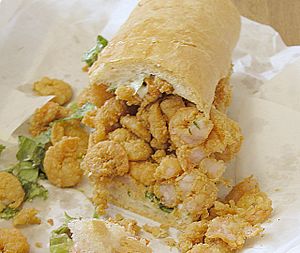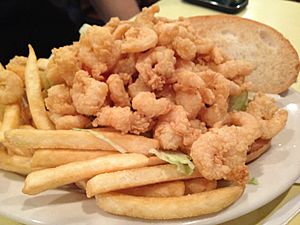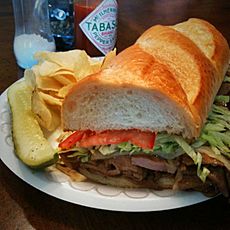Po' boy facts for kids

Shrimp po' boy
|
|
| Alternative names | po-boy po boy |
|---|---|
| Place of origin | New Orleans, Louisiana |
| Region or state | Louisiana, Southeast Texas, Alabama, Mississippi, Georgia, South Carolina, Southeast North Carolina and the Florida Panhandle |
| Main ingredients | Multiple |
| Variations | Multiple |
A po' boy is a famous sandwich from Louisiana, USA. It usually has meat or fried seafood inside, like shrimp, crawfish, fish, oysters, or crab. This yummy filling is served on special New Orleans French bread, which is crispy on the outside and soft in the middle.
Contents
What's Inside a Po' Boy?
A po' boy can have many different fillings, as long as it uses the special "po' boy bread." Some popular fillings include roast beef, baked ham, fried shrimp, fried crawfish, fried catfish, Louisiana hot sausage, French fries, fried chicken, and even alligator or duck!
The Special Po' Boy Bread
"Po' boy bread" is a unique type of French bread. It's made with less flour and more water than a regular baguette. This makes the dough wetter, which helps the bread become lighter and fluffier. This recipe was created a long time ago because it was hard to grow wheat in the humid climate of the Gulf South, so flour had to be brought in.
How Po' Boys Are "Dressed"
A "dressed" po' boy means it comes with lettuce, tomato, pickles, and mayonnaise. If you order a fried seafood po' boy, it often comes with melted butter and sliced pickles by default. You can also add a Louisiana-style hot sauce if you like spicy food. Po' boys that don't have seafood often come with Creole mustard.
Since the Great Depression (around 1929), cheese has also been a popular ingredient in po' boys.
Different Kinds of Meat Po' Boys
The New Orleans "sloppy roast beef" po' boy is a favorite. It can have thick slices of beef with gravy, or beef that's cooked until it's super tender and mixed with its sauce. Another style uses thinner slices of beef dipped in beef jus (a flavorful juice). Sometimes, garlic is added for extra taste. Roast beef po' boys often come with "debris," which are small bits of meat that fall off during cooking and mix with the gravy, making it extra rich.
Where Did the Name "Po' Boy" Come From?
In the late 1800s, fried oyster sandwiches on French bread were called "oyster loaves" in New Orleans. This name is still used today. A sandwich with both fried shrimp and fried oysters is sometimes called a "peacemaker."
A popular story says that the name "poor boy" (which later became "po' boy") started in a New Orleans restaurant owned by brothers Benjamin and Clovis Martin. They used to be streetcar conductors. In 1929, during a four-month strike by streetcar workers, the Martin brothers gave free sandwiches to their former co-workers.
Benny Martin said that they would jokingly call an incoming striker "another poor boy." This is how they said the name came about. However, some historians think this story might not be entirely true because it wasn't written about until many years later. Before 1969, the Martin brothers themselves said they created the po' boy for farmers, dock workers, and other "poor boys" who visited their first restaurant.
Po' Boys in New Orleans

New Orleans is famous for its fancy restaurants, but simple foods like the po' boy are also very popular. You can make po' boys at home, buy them in stores, or find them at deli counters and most local restaurants. Many basic New Orleans restaurants are actually po' boy shops. These shops often sell other local dishes like seafood platters, red beans and rice, and jambalaya.
The two main bakeries that make po' boy bread are the Leidenheimer Baking Company and Alois J. Binder. People in New Orleans often have strong opinions about which po' boy shop is the best!
Every year, New Orleans hosts a festival just for po' boys called the Oak Street Po'Boy Festival. It's a one-day event in mid-November with live music, art, and many food vendors selling different kinds of po' boys. The festival even gives out "best-of" awards, which encourages chefs to create new and exciting po' boy ideas.
Po' Boy Variations Across the US
You can find real Louisiana-style po' boys along the Gulf Coast, from Houston all the way to the Florida Panhandle. The name "po' boy" has also spread to other parts of the country, like the South Atlantic States and California. In these places, it might refer to different kinds of submarine sandwiches.
Houston's Unique Po' Boy
Houston has its own special po' boy. It includes chowchow (a pickled relish) added to ham, salami, and provolone cheese. This version was created in the 1960s by Syrian and Lebanese restaurant owners. It became a very important part of Houston's food culture. Jalal Antone, a Lebanese American owner of Antone's Import Company, created it in 1962. He wanted to make something familiar for local people since Levantine cuisine (Middle Eastern food) was not well known then.
The Houston po' boy was very popular in the 1970s and 1980s. However, with the rise of big sandwich chains and the introduction of bánh mì (Vietnamese sandwiches), its popularity has decreased a bit.
Vietnamese Influence
Since the 1970s, many Vietnamese people have moved to the Gulf South, including New Orleans. This has led to some interesting mixes between po' boys and bánh mì sandwiches.
Images for kids
See also
 In Spanish: Po' boy para niños
In Spanish: Po' boy para niños



